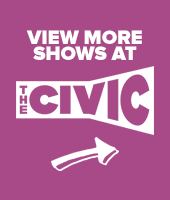Can the experience of a play be captured successfully on film? And if so, how do you do it? Do you just put a camera at the back of the audience? Or do you take advantage of close-ups and editing? How can you translate theatricality – into something cinematic? To not just capture an archive of the show – but to fully translate it into a fulfilling engagement on screen?
These were the questions The Civic’s Theatre Company in Residence AboutFACE were asking this August, in a research and development workshop entitled “From Stage to Film,” taking over the theatre for nine days of exploration.
Thanks to a Capacity Building grant from the Arts Council, AboutFACE were able to team with film company Gansee Films to explore this process. Tim Gannon and Graham Seely are experts in capturing live performance, having shot productions for Irish National Opera, among others. And the workshop quickly became a fascinating crossover between AboutFACE’s theatre perspective and Gansee’s filming point of view.

To examine the questions practically, a pre-existing production was revived to be captured – AboutFACE’s production of “The Gods of the Ozarks” by Matthew Cole Kelly, which premiered at The Civic in 2019. This was a very deliberate choice as the show would be challenging to film – not only did it have a large cast of eight actors, but it was a highly theatrical show (rather than a “kitchen sink drama” in a realistic set), driven by dynamic movement, multiple locations that were signified very simply in the set, and many elements requiring the audience’s imagination. How would these translate on screen?
Over the course of the workshop, we explored many aspects – such as audience eye versus camera perspective? The difference in lighting for theatre versus film? How actors performance levels are effected – not just by the closeness at time of the camera, but also with a different way of working, where filming requires different periods of waiting in the work day? How to sustain a feeling of liveness within scenes and in transitions? How to translate heightened stage language and movement to film without losing the inherent theatricality? When does using a close-up or a moving camera or seeing something from a character’s perspective add to the storytelling – and when is it jarring? What’s the difference between filming with an audience present versus a live stream without an audience versus a recording that is edited together and broadcast later – or what’s the possibility of a combination of all of the above?

We were lucky in that the workshop proved to be a real collaboration, a genuine process of exchange and exploration, with a great sense of fun and adventure even when the work was demanding – with room for input from all of the team in the room, between Graham and Tim on the film side, from Anna our director and our designers and crew, and with feedback from the cast. It was notable how it was not just how much the AboutFACE gang were learning about the use of filming, but also how the Gansee team said how much they learnt about the theatre side of things. It was confirmed to us that what we were doing was a hybrid between theatre and film, with its own (exciting) rules.
Additionally, returning to the play after two years was in itself fascinating. The actors all noted that they found new perspective and depth of understanding about their characters. And the play itself suddenly had new resonances – its story of how a grief-stricken doctor restores the faith of his community struggling with the impact of deaths from a mysterious disease, meant so much more to us all having lived through our own pandemic.
The goal of the workshop was to build our capacity, and we believe that has been a success. We learnt so much by trying things, sometimes failing, sometimes getting great results, and in adapting to our learnings as the workshop went on, with the course of things often turning out very differently than we expected, but always fascinating and informative. We’re really excited about the many discoveries we’ve made about how to film and share a play digitally going forward. One of the lessons was that, of course, nothing replaces seeing the show in-person. But that we now know so much more about how to create a filmed version that is artistically satisfying, captures the story in a new way, and which will hopefully enable it to reach many more people, who might not otherwise be able to see it.

With thanks to the Support of Arts Council Ireland






























